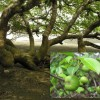Abstract
This poisonous tree is native to southern Florida, the Keys, many of the Caribbean islands, Mexico, and Central America. Though it is poisonous to humans and many animals, iguanas eat the fruit and sometimes live among the tree’s limbs. It’s found along the seacoasts and in brackish swamps where it grows among mangroves. Each leaf has a small gland where the leaf joins the stem. The bark is reddish-to-grayish brown and cracked looking. Flowers inconspicuous, but the spikes or leafless stems that the flowers emerge from are visible. The fruit is bright-green and looks like a small apple. This 2-page fact sheet was written by Michael G. Andreu and Melissa H. Friedman, and published by the UF Department of School of Forest Resources and Conservation, July 2012.
References
The Institute for Regional Conservation (2012). The Floristic Inventory of South Florida Database Online. Retrieved from http://regionalconservation.org/ircs/database/plants/PlantPage.asp?TXCODE=Hippmanc.
USDA Natural Resources Conservation Service (n.d.). Plants Database. Retrieved from http://plants.usda.gov/java/nameSearch?keywordquery=hIPPOmane+mancinella&mode=sciname&submit.x=0&submit.y=0.
Wunderlin, R. P., & Hansen, B. F. (2008). Atlas of Florida Vascular Plants. Retrieved from http://florida.plantatlas.usf.edu/Plant.aspx?id=2806.

